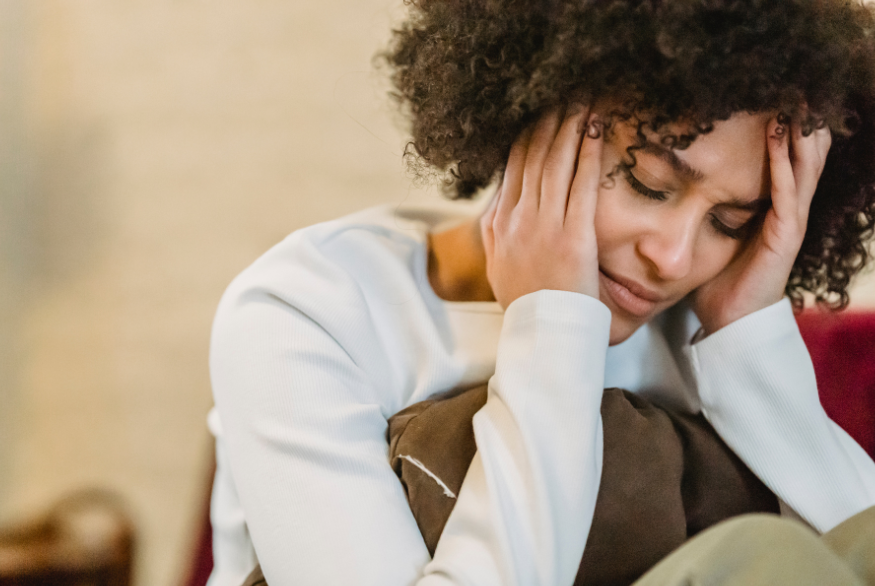Understanding PMDD: My Journey to Diagnosis and Management

For many women who menstruate, the days leading up to their period may involve mood swings or fatigue. For some, the premenstrual phase can feel draining, anxious, depressive, with a profound sense of feeling out of control. This is the reality for women with Premenstrual Dysphoric Disorder (PMDD). I’ve personally experienced the intense symptoms of PMDD, a condition that goes far beyond typical PMS.
In this post, I’ll share how I learned about my PMDD diagnosis, the lifestyle changes that have helped me manage it, and the ongoing challenges I still face. My hope that by sharing my story, I raise awareness and help those who are struggling with PMDD feel understood and empowered to take control of their health and well-being. I also want to reach those who don’t have PMDD themselves but have a loved one who might be experiencing it. By shedding light on this condition, I hope to foster understanding and compassion, while providing insights into how they can offer meaningful support to those dealing with PMDD.
What is PMDD?
Premenstrual Dysphoric Disorder (PMDD) is a severe form of premenstrual syndrome (PMS) that affects up to 10% of menstruating individuals. Unlike PMS, which causes mild to moderate discomfort, PMDD leads to intense depression, anxiety, feelings of being overwhelmed or out of control, sensitivity to rejection, social withdrawal, and other debilitating emotional and physical symptoms. It can also cause conflicts with family, coworkers, or friends, further disrupting daily life, relationships, and work.
PMDD symptoms typically occur during the luteal phase of the menstrual cycle, usually 7 to 14 days before menstruation begins. This condition often goes undiagnosed or is mistaken for other mental health issues, like depression or anxiety, because of its similar symptoms.
Common Symptoms of PMDD
PMDD symptoms are intense and vary from month to month. They typically improve once menstruation starts, but they can be overwhelming during the luteal phase. These symptoms are both emotional and physical, and they include:
Emotional and Psychological Symptoms:
- Severe mood swings: Intense irritability, anger, sadness or feeling on edge.
- Depression: Feelings of hopelessness, worthlessness or suicidal thoughts.
- Anxiety: Overwhelming worry, tension, or panic attacks.
- Fatigue: Extreme tiredness, low energy that makes it hard to function.
- Cognitive difficulties: Difficulty concentrating or remembering things.
- Social withdrawal: A desire to isolate oneself from others.
Physical Symptoms:
- Sleep disturbances: Insomnia or sleeping too much.
- Headaches: Migraines or tension headaches.
- Joint or muscle pain: Unexplained body aches and pains.
- Bloating: Swelling and discomfort in the abdomen.
- Breast tenderness: Soreness or swelling of the breasts.
- Changes in appetite: Increased cravings, especially for carbohydrates or sweets.
The severity of symptoms can vary from month to month, but for those with PMDD, the symptoms are often debilitating enough to interfere with daily life.
A Desperate Moment: My First Experience with “My Dark Side”
I was 17 years old, the first time I tried to take my own life. Before going to sleep, I drank a bottle of my dad’s pills, downing them with a bottle of vodka.. I was so angry, hurt, and upset with my parents. I remember feeling deeply conflicted, devastated and overwhelmed by my emotions that it became too much for me to handle. It was very hard for me to process everything that was happening within my family. I often felt overwhelmed by the dynamics at home, which left me struggling to find my own sense of freedom and understanding. In that very moment, my body felt completely unbearable, unable to cope with the flood of emotions I was experiencing and my mind wanted out.
The next morning, I woke up feeling confused because I was still alive. I didn’t feel angry or devastated anymore. At the time, I was attending an adult school, so I got ready for school like it was any other day. But soon after I arrived at school, I began to feel very sick. While outside with my friend Johanna, I shared with her what I had done. I told her, “I did something foolish,” then continued, “I need to go to the hospital. I don’t want to die.”
We went to the hospital, where they made me drink activated charcoal, and I lived. Days after, I went to mandatory therapy since I was still underage, it was a requirement. After a couple of sessions, my therapist didn’t think I was suicidal. She thought I had a good head on my shoulders, a strong will to live and she said she thought I had just experienced a moment of weakness and frustration. I almost think she believed I did it for attention. At the time, I felt I had such a strong will to live and to have fun that I didn’t think anything was really wrong with me. The intense feelings that made me act that way seemed nonexistent. So, I didn’t really think I needed therapy, so I stopped going.
Noticing Patterns: My Self-Diagnosis Journey
Maybe about two years later, I found myself in my first toxic relationship with a controlling, abusive person. Of course, it wasn’t like that at first, things only changed after we moved in together. It wasn’t long before I tried to hurt myself again. But this time, I had a moment of clarity: I knew the relatioship was not going to last, I needed to break up with him. I left, knowing that staying in that relationship would be the end of me.
After I broke up with him and moved out, I was bitter, bitter from everything I had experienced with him. I continued to then spiral into anger, then depression, overwhelmed by suicidal thoughts or caught in intense anxiety. I had no idea what was happening to me, why I felt this way or why my emotions were a little extra and burst out of nowhere, especially when I had set myself free from him. But then I realized something, I found myself feeling relieved from my intense emotions after my period would come a few days later.
When I was about 26 years old, my friend Christina told me about Premenstrual Dysphoric Disorder (PMDD). She mentioned a website where I could track my moods and symptoms over a few months, so that I can take the results to my doctor for a diagnosis. The patterns in my behavior clicked, and it made sense that it was exactly what I was going through.
The Discovery of PMDD: Tracking Symptoms and Finding Answers
Eventually, after some time, I began keeping a journal and tracking my period to provide to my doctor. That’s when I realized that almost every month, just a few days before my period, my emotions, thoughts, and physical sensations would intensify, leaving me feeling mentally, emotionally, and sometimes physically overwhelmed. Over time, I noticed that this started happening earlier, sometimes as much as seven days before my cycle, or even two weeks before, making me feel like I was losing control of myself.
For me, the emotional outbursts typically last from one to three days, but they also seem to depend on what is going on in my life. Each month is different. I noticed that if I am experiencing a particularly stressful or challenging time, that time of the month may be more challeging. I may lose control, especially if I am not aware of my cycle. If my life is balanced, I might not feel any symptoms, or I might only cry over something small or over nothing at all. Sometimes, I might lose my patience, feel angry, feel extremely overwhelmed, or experience significant bodily discomfort. In my worst moments, such as when I was grieving, or in a toxic relationship, or going through a specific tough moment, it was harder to deal my emotions and sometimes had thoughts of ending my life. I also realized that when I hold things back or don’t express my feelings, I have lashed out during that time of the month. It always depends on my stress level at the moment.
Realizing that I wasn’t ‘crazy’ or just overreacting was an eye-opener. I had a medical condition, PMDD, that triggered these emotional swings. Understanding PMDD was both a relief and a wake-up call, helping me finally understand why I felt and acted the way I did at times.
Ongoing Challenges and Coping with PMDD
Even after learning about PMDD, the challenges continued. Life’s stresses are inevitable, and PMDD amplifies everything, making it harder to handle life. On normal days, I might put a “band-aid” on difficult emotions, but if I don’t handle those emotions in the moment, process, forgive and let go, during the luteal phase of my menstrual cycle, PMDD may rip that band-aid off, overwhelming me with all kinds of emotions.
When I don’t maintain a healthy lifestyle, PMDD symptoms like anxiety and depression, become harder to manage. Neglecting exercise or meditation causes stress to build, making everything feel more challenging during that time of the month. Coping with stress is crucial, but it’s tough when life gets busy.
Tough experiences, like heartbreak and grief, have left me at my lowest, but they’ve also motivated me to make changes in my life to better manage PMDD because I want to live a better life, feel better, and stay open-hearted. Another challenge is the physical symptoms, bloating, headaches, and discomfort in my own body. I try to manage these by maintaining a balanced diet, reducing sugar, staying hydrated, and exercising. Massages and saunas also help alleviate discomfort.
Self-care is essential. I’ve found that regular exercise, meditation, and journaling help me manage emotional shifts and track triggers. When the emotional turbulence hits, I remind myself it’s temporary and practice self-compassion. Having a support system is important, though explaining PMDD to others who don’t understand, or who forget, especially during moments of conflict can be challenging. Since these episodes don’t happen often, some people close to me still don’t fully understand what I’m going through. Many times, I’ve felt misunderstood, and still do, especially during emotional outbursts. Sometimes, simply isolating myself and asking for space is necessary. Still, focusing on self-awareness and managing stress has helped me cope with the ups and downs more effectively.
Supporting Loved Ones with PMDD
For anyone wanting to support a loved one with PMDD, understanding, compassion, and patience are key. Avoid dismissing their feelings or telling them to “just get over it.” Instead, listen, validate their experience, and create a safe space for expression. Simple phrases like, “I’m here for you” or “How can I support you?” can make all the difference.
It’s also important to recognize that emotional reactions can be influenced by both the condition and personal factors. If someone with PMDD is going through a particularly stressful time, their symptoms may be more intense than usual. Compassion plays a central role here, understanding that emotional outbursts may be triggered or amplified by PMDD, but also by personal stressors, encourages more empathy and reduce misunderstandings. Be patient and nonjudgmental, and encourage open communication. Check in with questions like, “How are you today?” or “Is there anything you need from me?”
Setting boundaries is vital for both parties. When overwhelmed, it’s okay to say, “I need space,” and reconnect later. Loved ones should not take it personally if their partner needs time alone, it’s a way of managing emotions, not a reflection of their feelings toward you. Being clear about each other’s needs helps prevent tension and promotes healthier interactions.
Finally, a strong support system is essential. Healthy relationships make it easier to manage emotional shifts. Some of my friends and family now understand that I might need extra space or patience during certain times. By communicating openly about my PMDD, I’ve strengthened my relationships, even in tough moments.
Treatments and Strategies That Have Helped
I’ve tried a few different treatments, including antidepressants and birth control, but not any have worked for me. The most effective treatment for me has been a combination of lifestyle changes and self-awareness: exercising regularly, a balanced diet, eating nutrient-dense foods, cutting down on sugar, limiting alcohol (or not drinking at all), meditation, affirmations, and sound healing, basically, a holistic approach to reduce stress and stay balanced. Meditation and mindfulness have helped manage stress, and journaling has allowed me to get to know myself deeper, track my emotional triggers, helping me prepare for vulnerable days. Affirmations are important because they help reframe negative thoughts and encourage self-compassion, building resilience and promoting a positive mindset, which is vital for tough days.
Staying true to myself and living authentically reduces stress. Hobbies like dancing, kiteboarding, rock climbing, and sailing bring me joy and help keep me grounded. Most importantly, tracking my cycle and being mindful of my symptoms allows me to manage PMDD more effectively. It’s about being prepared and having strategies, like resting or doing something comforting, when symptoms come up.
When I feel the familiar shift in my body, I stay self-aware, reminding myself that these hormonal changes will pass. While I can’t control it, I can learn to accept it and navigate more effectively.
Seeking Help and Keeping a Journal
We are all different and may respond to treatments in unique ways. I encourage anyone who thinks they may have PMDD to seek help from a healthcare professional. Bringing a journal to your doctor that tracks your symptoms over time can be incredibly helpful in getting an accurate diagnosis. Journaling allows you to identify patterns in your emotional and physical responses, and it provides your doctor with a clear picture of what you’re experiencing. There are also a variety of treatment options available for PMDD, including medication, therapy, lifestyle changes, and alternative treatments.
Remember, you don’t have to go through this alone. By staying informed, tracking your symptoms, and seeking professional help, you can find the right combination of treatments that work for you.
Final Thoughts: Embracing Awareness, Support, and Self-Compassion
Living with PMDD is an ongoing journey, but understanding the condition has made me feel more in control. Although, I am still mostly at the mercy of my emotions at that time of the month, I’ve learned to recognize the signs, be more mindful of them, manage the worst days, and ask for help when I need it.
If you are struggling with PMDD, know that you are not alone. Be patient with yourself, seek help, and remember that it’s okay to ask for support. Educating yourself, and others, about PMDD can make all the difference. Self-compassion is key. Acknowledge that you’re doing the best you can, even on the tough days.
Remember, it’s okay not to have everything figured out. PMDD is challenging, but with the right support, self-awareness, and treatment, it’s possible to manage it and live a fulfilling life.
If you’re struggling with PMDD or know someone who is, I hope my journey has shed light on the importance of recognizing the condition and seeking the support you need. Don’t let shame or fear keep you from asking for help, your well-being matters. You’re not “crazy.” You’re human. And you deserve understanding, compassion, and a way to navigate the life that works for you.
References:
- Cleveland Clinic. (2023). Premenstrual Dysphoric Disorder (PMDD). Retrieved from https://my.clevelandclinic.org/health/diseases/9132-premenstrual-dysphoric-disorder-pmdd
- Johns Hopkins Medicine. (2024). Premenstrual Dysphoric Disorder (PMDD). Retrieved from https://www.hopkinsmedicine.org/health/conditions-and-diseases/premenstrual-dysphoric-disorder-pmdd








Very well written. Informative for women dealing with it
Beautifully written. Thank you for sharing and educating me on PMDD.
I love your story, well written and understandable, make me aware of the things I’ve been struggling with my daughter through the years. Keep it up there’s so many women that are going through this phase every month and don’t understand what are they going through!
Courageously said on a taboo women’s issue. Crazy has been the narrative for too long; speaking up and sharing like you are matters to get more attention, research and support for this and all women’s issues.